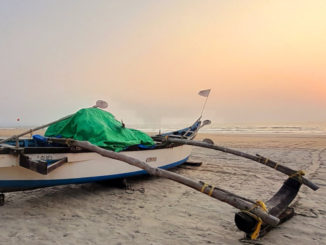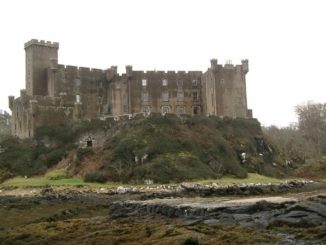REFLECTIONS ON PIRACY
I appreciated the warm reception given to Part 15 from several people and thank them all for reading and commenting on it. I especially wish good fortune and happy sailing to those embarking on the water themselves whether in a canoe, dinghy, small sailing boat or a larger craft. I also thank El Cnutador in particular for clarifying that he was really teasing me when asking several times for something about Pirates.
I hope readers will detect a sense of excitement and innocence in these accounts of how I extended my limited sailing experience in my first full year of yacht ownership and would like to think they will learn more through my mistakes and successes; meet in their imaginations the people I met; and understand more about the places visited and their history. That is why I have used as many of my own photos as possible even though others of better quality are sometimes freely available. I don’t want to distract attention from those objectives by saying much about piratical events in advance of my own experience of sailing in waters where it became a potential concern.
If I have the time and energy to continue this series beyond the 1997 cruise then I might try to do something similar for Alchemi’s 1998 voyage which included an oceanic section to the Azores Islands from Atlantic Spain and Portugal, returning via Ireland’s western and southern coasts. I didn’t encounter any crime, let alone agressive piracy in either of those years, nor for the most part during 1999 or early 2000 when I crossed the Atlantic and sailed down the island chain in the Eastern Caribbean. I certainly don’t want to discourage any-one who might be contemplating a life on the ocean wave from doing so with numerous or scary stories about pirates.
On the other hand, I have already set a precedent by relating a couple of Yarns from later years and I don’t want to portray a falsely optimistic picture that a life at sea is totally carefree and without risk So, here’s a very brief summary of the worst act of piracy I heard about directly as the victims described their experience at a meeting of the Ocean Cruising Club at which I was present. The story is already in the Public Domain because it received quite a lot of Media coverage at the time.
Paul and Rachel Chandler were sailing in the Seychelles archipelago in 2009 en route to Tanzania when they were boarded and captured by Somali Pirates. Their yacht was cut loose and they were taken to the African mainland and confined for more than 12 months in appalling conditions. They were finally released upon payment of a ransom of about £260,000 raised by family and friends.
My own presence in the same area the previous year didn’t attract any media attention at all though I was robbed whilst on Mahe (principal island in the Seychelles). I arrived from SE Asia via the Chagos archipelago in which I had met other cruisers who described the Tanzanian coast as a fantastic cruising area and emphasised it had the added attraction of the Serengeti National Park in the interior. I might have decided to go there myself but didn’t because there was insufficient time to do so and round the Cape of Good Hope to get into the Atlantic during the same sailing season. Furthermore, by good luck or judgement I wasn’t sufficiently confident it would be safe to leave Alchemi in Tanzania itself during the 2008-2009 Cyclone Season and continued to South Africa via Northern Madagascar and the Mozambique Channel.
Risks of robbery or violence existed in all those places of course, but I’m not sure they were any worse than those of being in Hyde Park these days.
I’ll continue to reflect on these matters. Perhaps short “Out of Sequence” sections dealing with just one aspect of “Piracy” at a time would be a way of covering the topic in more detail.
1997 CRUISE – LEG 3
When planning my 1997 cruise I had realised three weeks would be needed for each of the first two legs if I was to complete them without undue haste. I reckoned four weeks would be needed to do the same for the next leg from Copenhagen to Bergen but couldn’t attract companions prepared to spend that length of time away from their normal lives.
One lady member of the Cruising Association with extensive sailing experience on her elderly father’s yacht had joined me for a number of weekends in the Solent and expressed some interest in a two week expedition but hummed and hawed about it for a long time during discussions before I left England.
In the end she surprised me by converting her interest into a definite proposition for two weeks up the Swedish West Coast from Copenhagen to Oslo, but she had a condition. It was that I should also extend an invitation to a friend of hers with whom she had sailed on an earlier occasion. I was even more surprised when the friend turned out to be an American lady living in New York and the previous experience had been sailing in Maine! So it was that I prepared the normal diagram for the revised leg 3. Here is the map for this leg but it comes with an alert about the misleading impresssion shown on it – The island of Sjaelland is continuous and it only looks as though the land north of the word Copenhagen is a separate island because of the white box in which it is written’
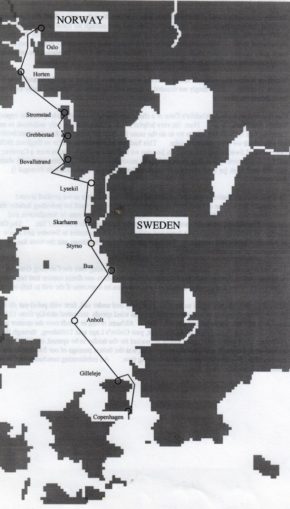
COPENHAGEN, GILLELEJE, ANHOLT AND BUA
Whilst on my own in Svanemolle marina I admired the skill of the local sailors.
I believe the marina has recently been modernised but in 1997 it had about one thousand berths of the single pontoon and pile mooring type into one of which Alchemi had been carefully positioned under motor by skipper and two crew. More than one local yachtsman disdained our own timorous technique.
I watched as one dropped the mainsail just outside his berth, glided into it at just the right speed, in just the right position, left the tiller and attached a line to the pile by himself then used it to stop the boat just in time for the single crewman to leap off the bow and secure their craft with a line quickly looped around a pontoon cleat. The pair doing this must have practised the manoeuvre often but it was an impressive bit of boat-handling I can still visualise 24 years later.
I had no difficulty in meeting my new crew. Walking along the road outside the marina on Saturday 28 June I saw coming towards me on the other side of the road a stylish looking woman with dark and short curly hair carrying a sailing holdall – I greeted her with “Hello, I think you must be G…… from New York” and that turned out to be right on the button. My friend from the CA arrived later the same day having flown in from Heathrow.
Sunday began with little wind and dense mist but gradually conditions improved and we were sailing well as we approached Helsingor Palace.
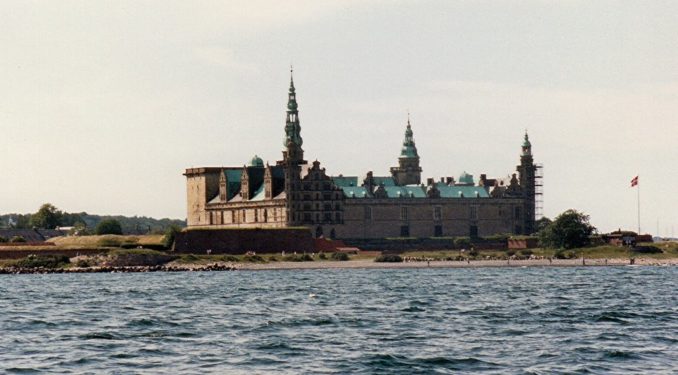
This is the Elsinore Castle of Shakespeare’s Hamlet. The present-day palace seems a far cry from the military castle of my imagination and Olivier’s film, but perhaps the comparison would have been closer if we’d arrived before the morning mist had lifted and we hadn’t been able to see the Navigation Light in one of the corner spires.
We had hoped to stay overnight at the Helsingor marina, or at least at the Hornbaek one 10 miles up the coast. In this we were disappointed because it turned out this was the last day of the annual “Round Sjaelland” yacht race and all the berths were full. We knew that was true because we motored up and down every minor berthing lane in a vain search to find a space. In the end we went on to Gilleleje harbour at the northern tip of Sjaelland and moored to a large ship wharf. This turned out to be an interesting stop with neat thatched cottages and a colourful harbour.
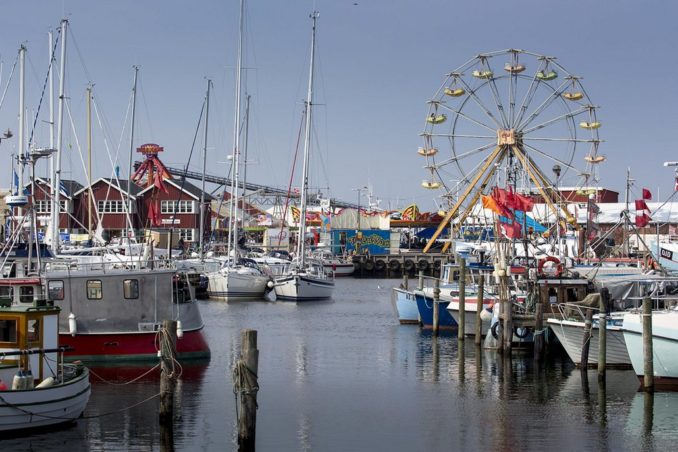
The next day’s trip to Anholt was enlivened by two developments.
The first was another fierce electrical storm with an accompanying wind front that started when I was off-watch and resting in the cabin. We’d had the full mainsail up so the boat had started heeling, turning into the wind and so-on. The experienced lady crew-member had reacted by completely dropping the mainsail. That certainly dealt with the heeling and over-lively movement but it also left the sail all over the deck and the reefing lines in a huge tangle around themselves, the sail and the boom – it took a good half hour to sort it all out.
The second development was noticing the GPS readings were erratic. At first I thought that might have been a collateral effect of the lightning but the hand-held instrument I had bought as a back-up reported “poor GPS reception” and seemed to be much more reliable than the fixed system installed when the yacht was built. That was pretty concerning at the time but I learned then and for the rest of the voyage to rely on the hand-held instrument and forgo the supposed benefit of the signal from the fixed instrument being displayed on the primitive digital chart plotter.
In these early years I was in any case navigating with the use of paper charts and hand-marked symbols of yacht-position, but I was pretty miffed the expensive system installed wasn’t working properly. During the next annual maintenance the problem was found to be a fault in the antenna unconnected with the electrical storm and after a replacement was fitted the correct signal reached the primitive chart plotter again. I still had to use paper charts for the rest of the 1997 voyage though and for many years afterwards.
That became a bit of a problem in its own right as they took up so much space and weighed so much, along with other additional gear, that the yacht floated about two inches lower in the water when fully laden with three crew, fuel, water and stores for a long voyage. As a consequence, I had to raise the boot line when in the Caribbean and dispense with it altogether in the Pacific by applying anti-fouling to the part of the hull it originally adorned. Doing that did of course reduce the self-righting characteristics of the yacht but it was either that or throw away charts I might later need again. This is an example of the common experience of most live-aboards – that whatever the length of one’s yacht one would really like it to be about three feet longer to accommodate essential possessions.
The harbour at Nordbjerg (on Anholt) is little more than a ferry and fishing base with a large number of moorings for visiting yachts. The small supermarket and other facilities on shore barely seemed to justify the most expensive fees we had experienced so far. We concluded most yachtsmen come to Anholt because of its convenient position rather than its attraction as a destination.
Our next stop was at Bua Hamn in Sweden notable for me mainly because it was close to the Ringhals Nuclear Power Station with which I had associations from my working life.
It was also fun because of the following experience (it may be different nowadays of course) –
Refuelling involves waiting a considerable time for the attendant at the roadside petrol station to pass the time of day with all his friends who call while you are there. When he has nothing else to do he will pump a specified volume of diesel into a large steel box on wheels, curse the disappearance of a tap key at the delivery nozzle and replace it with an adjustable spanner that later proves to be ineffective. Finally, you can push the recalcitrant box on wheels to the quay where you can wrestle with the boa-constrictor like hose and finally deliver most of the fuel into the yacht’s tank.
THE BOHUSLAN ARCHIPELAGO
The city of Gothenburg on the Swedish west coast is situated about 130 miles north of Copenhagen. The body of water between the two cities is called the Kattegat and is protected from North Sea storms by the Jutland peninsula. The sea north of the Kattegat, and south of the Norwegian coast is called the Skagerrak. From Gothenburg it is about 95 miles to the Norwegian border and then another 70 miles or so to Oslo of which about one half is in the Skagerrak and the remainder up the long Oslo Fjord.
The Swedish coast between Gothenburg and the Norwegian border is riven by short fjords, some with waterways between them, and most with many granite islands offshore their seaward coasts. In between and around the islands are many rocks awash or just beneath the surface. This is the Bohuslan Archipelago.
In some sections there is a well-buoyed and deep channel inside a string of islands that is seldom rough even in strong winds when waves are piling up and breaking in the open sea. Such channels are however relatively narrow so being able to sail along them is critically dependent on wind direction and motoring is often needed.
At the head of the Bohuslan’s fjords there is often some flat and fertile land on which dwellings, villages or even small towns have been built in much the same way that can be seen at the head of lochs in Scotland. In Scandinavia such a place is called a “vik” and one of several possible explanations of how the word “Vikings” evolved is based on the idea these are the sort of places where people known under that generic name originated. Attractively simple though that idea is many etymologists prefer more complex explanations because they find gender incompatibilities in the simple one.
STYRSO
One of the southernmost islands is large enough to be inhabited and to have vegetation upon it and is named Styrso.

Traditionally the islanders were fishermen and there is still an active fleet operating from the small harbour. These local residents were joined during the twentieth century by some of their more prosperous countrymen who built large houses as summer retreats, so modern Styrso is quite densely populated.
The island has two supermarkets, a post office and regular ferry services to the mainland but is not all that large. A sign near the harbour states cars and motorcycles are banned and its true we saw only one or two commercial vehicles. But the local population seems to observe the ban more in the letter than the spirit.
The most popular form of transport was a motorised scooter transformed into a tricycle by replacement of the front wheel with a large flat wooden platform mounted on an axle with a wheel at each end. All manner of people and things are carried on these platforms from a bag of shopping to the children being taken to and from school. We saw one carrying a large sofa on which a young man was reclining and waving to his friends as he passed.
The Swedish people are quite patriotic and many fly their national flag on a pole in their garden. We were there on the 4th July and one gentlemen in a garden we passed was also flying the Stars and Stripes on a separate pole. Alchemi’s American crewlady didn’t bat an eyelid at the fact the flag was upside down and thanked the owner for celebrating her country’s birthday in as warm a manner as anyone could have wished. She was rewarded with a smile and a proud thrust of the owner’s chest.
MARSTRAND AND SKARHAMN
Marstrand is an island and town about 20 miles north of Styrso and is well known to sailors. So well known in fact that there was a yachting festival all week whilst we were in the neighbourhood so we decided not to visit.
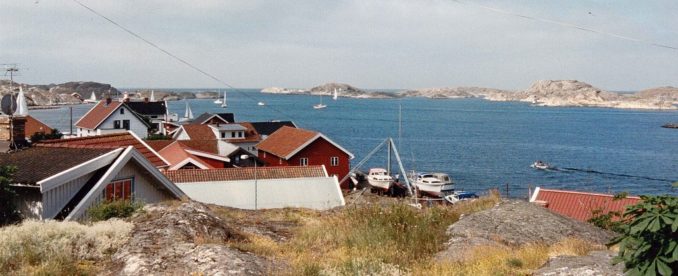
Instead we sailed past numerous hazards, close-tacking for part of the time between channel buoys on one side and swirling water indicating rocks just beneath the surface on the other, before giving up to motor-sail a straight course into the wind before mooring overnight at Skarhamn.
ORUST AND LYSEKIL
The island of Orust is famous in yachting circles because traditional boat-building skills have been adapted and applied to yachts. The famous “windscreen cruisers” – Hallberg Rassy, Najad and Malo have all been built on the island for many years.
We didn’t visit in 1997 but I have another association with the island that might have been anticipated by four or five years had we done so. In late 2000, Swedish Peter and I sailed our yachts from Trinidad in company with one another along the chain of Venezuela’s offshore islands and have been friends ever since. He lives on Orust and in recent years we have visited one another’s homes and are in reasonably frequent contact by email, ‘phone and video connections. I sometimes wonder if we would have met if Alchemi had stopped at Orust in 1997 but the answer is ‘probably not’ because its quite a big island and he was likely off sailing somewhere else anyway.
Like many Swedes and Norwegians Peter now owns a 20-30 foot motor boat with a small cabin and a large engine. These are in truth more suitable than a sailing yacht along the rock-strewn coasts sheltered by offshore islands and in high-sided fjords where the wind is so often unreliable and unpredictable. Peter sometimes uses his to visit his daughter in Lysekil which was our next stop in 1997.
At that time the town was quite different from previous harbours at which we had stayed since it was crowded, large, and noisy with the celebrations of young Swedes on holiday. Perhaps its still like that in high summer. For the same reasons it was an excellent place to re-stock with food, fuel and all the other necessities of a cruising life.
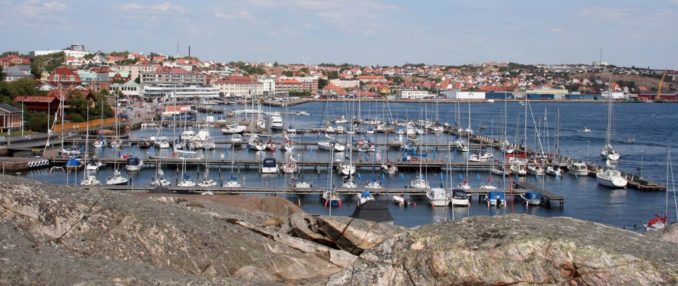
My original narrative and images for this article continued without a break to include accounts of what happened next including arrival and activities in Oslo but became too long for publication in a single instalment. Rather than omit descriptions and digressions I think some readers will find interesting I have chopped my original work into two chunks and hope readers interested in the story will be patient until Part 17 appears.
To be continued …………….
© Ancient Mariner 2021
The Goodnight Vienna Audio file
Audio Player


